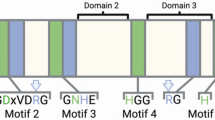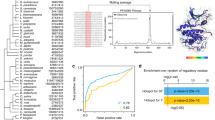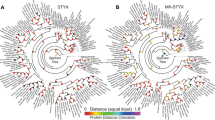Abstract
Homologs of the Escherichia coli surE gene are present in many eubacteria and archaea. Despite the evolutionary conservation, little information is available on the structure and function of their gene products. We have determined the crystal structure of the SurE protein from Thermotoga maritima. The structure reveals the dimeric arrangement of the subunits and an active site around a bound metal ion. We also demonstrate that the SurE protein exhibits a divalent metal ion-dependent phosphatase activity that is inhibited by vanadate or tungstate. In the vanadate- and tungstate-complexed structures, the inhibitors bind adjacent to the divalent metal ion. Our structural and functional analyses identify the SurE proteins as a novel family of metal ion-dependent phosphatases.
This is a preview of subscription content, access via your institution
Access options
Subscribe to this journal
Receive 12 print issues and online access
$189.00 per year
only $15.75 per issue
Buy this article
- Purchase on Springer Link
- Instant access to full article PDF
Prices may be subject to local taxes which are calculated during checkout



Similar content being viewed by others
References
Lima, C.D., Klein, M.G. & Hendrickson, W.A. Science 278, 286–290 (1997).
Hwang, K.Y., Chung, J.H., Kim, S.-H., Han, Y.S. & Cho, Y. Nature Struct. Biol. 6, 691–696 (1999).
Li, C. et al. J. Bacteriol. 176, 6015–6022 (1994).
Li, C., Wu, P.-Y. & Hsieh, M. Microbiology 143, 3513–3520 (1997).
Visick, J.E., Ichikawa, J.K. & Clarke, S. FEMS Microbiol. Lett. 167, 19–25 (1998).
Tréton, B.Y., Le Dall, M.-T. & Caillardin, C.M. Curr. Genet. 22, 345–355 (1992).
Kwak, J.E. et al. Acta Crystallogr. D 57, 612–613 (2001).
Zhang, M., Zhou, M., Van Etten, R.L. & Stauffacher, C.V. Biochemistry 36, 15–23 (1997).
Holm, L. & Sander, C. J. Mol. Biol. 233, 123–128 (1993).
Volz, K. & Matsumura, P. J. Biol. Chem. 266, 15511–15519 (1991).
Müller-Dieckmann, H.-J., Grantz, A.A. & Kim, S.-H. Structure 7, 1547–1556 (1999).
Chen, X. et al. J. Bacteriol. 181, 7107–7114 (1999).
Stukey, J. & Carman, G.M. Protein Sci. 6, 469–472 (1997).
Li, Y. & Strohl, W.R. J. Bacteriol. 178, 136–142 (1996).
Gordon, J.A. Methods Enzymol. 201, 477–482 (1991).
Geladopoulos, T.P., Sotiroudis, T.G. & Evangelopoulos, A.E. Anal. Biochem. 192, 112–116 (1991).
Otwinowski, Z. & Minor, W. Methods Enzymol. 276, 307–326 (1997).
Terwilliger, T.C. & Berendzen, J. Acta Crystallogr. D 55, 849–861 (1999).
de la Fortelle, E. & Bricogne, G. Methods Enzymol. 276, 472–494 (1997).
CCP4 Collaborative Computational Project, Number 4. Acta Crystallogr. D 50, 760–763 (1994).
Jones, T.A., Zou, J.-Y., Cowan, S.W. & Kjeldgaard, M. Acta Crystallogr. A 47, 110–119 (1991).
Brünger, A.T. et al. Acta Crystallogr. D 54, 905–921 (1998).
Barton, G.J. Protein Eng. 6, 37–40 (1993).
Kraulis, P.J. J. Appl. Crystallogr. 24, 946–950 (1991).
Merritt, E.A. & Bacon, D.J. Methods Enzymol. 277, 505–524 (1997).
Esnouf, R.M. J. Mol. Graphics 15, 132–134 (1997).
Brünger, A.T. Nature 355, 472–474 (1992).
Acknowledgements
We thank N. Sakabe and his staff for assistance during data collection at Photon Factory, beamline BL-18B. We also acknowledge the assistance of the staff at Pohang Light Source, beamline 6B and H.H. Lee. We thank the financial support from the Korea Science and Engineering Foundation (Basic Research Program grant no. 305-20000004). S.W.S. is supported by the BK21 program. J.E.K. is a recipient of the BK21 fellowship. J.M. is supported by the intern fellowship of KOSEF.
Author information
Authors and Affiliations
Corresponding author
Rights and permissions
About this article
Cite this article
Lee, J., Kwak, J., Moon, J. et al. Crystal structure and functional analysis of the SurE protein identify a novel phosphatase family. Nat Struct Mol Biol 8, 789–794 (2001). https://doi.org/10.1038/nsb0901-789
Received:
Accepted:
Issue Date:
DOI: https://doi.org/10.1038/nsb0901-789
This article is cited by
-
Structural insights into the mechanism of archaellar rotational switching
Nature Communications (2022)
-
Microbial 5′-nucleotidases: their characteristics, roles in cellular metabolism, and possible practical applications
Applied Microbiology and Biotechnology (2021)
-
The phosphorylated regulator of chemotaxis is crucial throughout biofilm biogenesis in Shewanella oneidensis
npj Biofilms and Microbiomes (2020)
-
High pressure inhibits signaling protein binding to the flagellar motor and bacterial chemotaxis through enhanced hydration
Scientific Reports (2020)
-
Rotational direction of flagellar motor from the conformation of FliG middle domain in marine Vibrio
Scientific Reports (2018)



